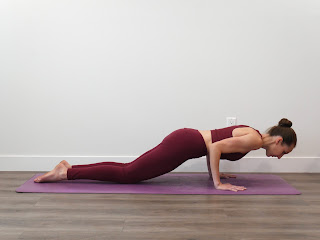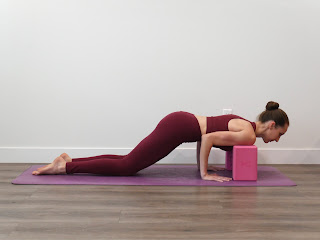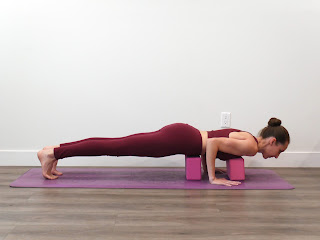Chaturanga Dandasana Breakdown
By: Steph Mitchell, ERYT500, RPYT, RCYT, YACEP, CAADC
By: Steph Ball-Mitchell, ERYT500, RPYT, RCYT, YACEP
In this chaturanga dandasana breakdown, we will explore the benefits of the posture, how to come into traditional chaturanga dandasana, contraindications for chataranga and accessibility options for chataranga dandasana.
Chaturanga is a posture that is offered to us repeatedly in a typical Vinyasa class. Most people have been doing Chaturanga Dandasana, four-limbed staff pose, incorrectly for years. This is because it's a very challenging pose. Many of us don't have the strength to maintain proper alignment. Repeatedly practicing this posture (or any posture) incorrectly can lead to serious injury. Many yoga practitioners have suffered rotator cuff injuries, shoulder strain, neck pain or low back pain from misaligned Chaturanga practice.
Probably the biggest issue we see with Chaturanga Dandasana is that most practitioners rush through it. This is especially true in the one-breath-per-movement Vinyasa classes with multiple sun salutations. It isn't the type of pose that you can breeze through quickly. It requires a sense of mindfulness because there are so many muscle groups involved in making this posture happen correctly. The pecs, the front of the shoulders and even the rectus abdominis are among the main muscles we call on for Chaturanga.
Aside from rushing the posture, we also see many practitioners collapsing towards the ground rather than lowering down with control. The hands are often placed too close to the shoulders which means the elbows won't hit the ninety degree angle when they bend, they will pass it. A lot of people don't fully bend at the elbow, often because they lack the upper body strength, and instead rush into upward facing dog. Splaying the elbows is another common alignment issue in Chaturanga Dandasana.
This is why it's important to take a look at the Chaturanga Dandasana breakdown. We want to know how to properly practice this posture and we want to look at accessibility options for this posture.

Start in plank. Bring the shoulders slightly over the wrists. Come up high on the toes. Press back through the heels to turn on the legs. Keep the abdominals engaged, the back strong. Lift the body as you inhale. On an exhale, let the elbows bend, squeezing them in towards the body. The elbows come right over the wrists as the body lowers. Maintain alignment, the body lowers as a unit until the shoulders reach the height of the elbows. Only lower to your own degree. If you feel that you’re losing your form, stop
Chaturanga Dandasana is in the traditional Sun Salutation sequence.



Chaturanga modifications
Founder of Online Yoga School and Yoga & Ayurveda Center
 Steph Ball-Mitchell, E-RYT-500, RPYT, RCYT, YACEP, CAADC
Steph Ball-Mitchell, E-RYT-500, RPYT, RCYT, YACEP, CAADC
Steph has over 25 years of experience in yoga and movement. Her understanding of yoga and the human body has been influenced by lifelong dancing and holistic health. She found her life’s purpose in helping people become happier and healthier through her own healing journey. Steph assists her students in knowing the joy and wonderment of integrating the mind and body through accessible yoga. She encourages an authentic and life-nurturing practice, one that brings greater consciousness to each moment and every movement of the body with a heavy emphasis on breath.
With a masters degree in counseling, Steph brings awareness, acceptance and a down to earth approach to her classes. She studied with Maty Ezraty and later completed her second 200-hour training with Nancy Candea at Yoga Impact in New Jersey and her 300-hour training with Chris Loebsack at Boundless Yoga Studio in Stroudsburg, Pennsylvania. The perpetual student, Steph has studied with Leslie Howard, Travis Eliot, Bryan Kest, Donna Farhi and countless others. She has extensive training in pelvic floor yoga, restorative yoga, yin yoga, power yoga and accessible yoga. Most recently, Steph was certified as a Grand Master of Meditation through Swami Vidyanand.
Steph founded Yoga and Ayurveda Center with her husband. She later launched Online Yoga School to support her local trainings and has recently launched a virtual yoga studio to accommodate the international community of trainees.
When she isn’t on her mat, Steph can be found volunteering, enjoying her husband and children, dancing and cooking. She currently enjoys serving on the board of World Yoga Federation and Meditation Alliance International and previously enjoyed serving on the Education Committee of Yoga Alliance and places a strong emphasis on inclusivity in her teacher trainings.